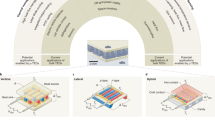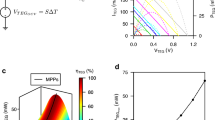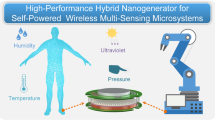Abstract
Powering the increasing number of sensor nodes used in the Internet of Things creates a technological challenge. The economic and sustainability issues of battery-powered devices mean that wirelessly powered operation—combined with environmentally friendly circuit technologies—will be needed. Large-area electronics—which can be based on organic semiconductors, amorphous metal oxide semiconductors, semiconducting carbon nanotubes and two-dimensional semiconductors—could provide a solution. Here we examine the potential of large-area electronics technology in the development of sustainable, wirelessly powered Internet of Things sensor nodes. We provide a system-level analysis of wirelessly powered sensor nodes, identifying the constraints faced by such devices and highlighting promising architectures and design approaches. We then explore the use of large-area electronics technology in wirelessly powered Internet of Things sensor nodes, with a focus on low-power transistor circuits for digital processing and signal amplification, as well as high-speed diodes and printed antennas for data communication and radiofrequency energy harvesting.
This is a preview of subscription content, access via your institution
Access options
Access Nature and 54 other Nature Portfolio journals
Get Nature+, our best-value online-access subscription
$29.99 / 30 days
cancel any time
Subscribe to this journal
Receive 12 digital issues and online access to articles
$119.00 per year
only $9.92 per issue
Buy this article
- Purchase on Springer Link
- Instant access to full article PDF
Prices may be subject to local taxes which are calculated during checkout




Similar content being viewed by others
Change history
24 January 2023
A Correction to this paper has been published: https://doi.org/10.1038/s41928-023-00927-x
References
Hassan, Q. F. (ed.) Internet of Things A to Z (Wiley, 2018).
Arias, R., Lueth, K. L. & Rastogi, A. The effect of the Internet of Things on sustainability. World Economic Forum https://www.weforum.org/agenda/2018/01/effect-technology-sustainability-sdgs-internet-things-iot/ (2018).
Sparks, P. The economics of a trillion connected devices. Arm Community Blogs https://community.arm.com/arm-community-blogs/b/internet-of-things-blog/posts/white-paper-the-route-to-a-trillion-devices (2017).
Pecunia, V., Occhipinti, L. G. & Hoye, R. L. Z. Emerging indoor photovoltaic technologies for sustainable Internet of Things. Adv. Energy Mater. 11, 2100698 (2021).
Harrop, P. Battery Elimination in Electronics and Electrical Engineering 2018–2028 (IDTechEx, 2017).
Kang, D. H. P., Chen, M. & Ogunseitan, O. A. Potential environmental and human health impacts of rechargeable lithium batteries in electronic waste. Environ. Sci. Technol. 47, 5495–5503 (2013).
Mineral Commodity Summaries 2022—Lithium (US Geological Survey, 2022); https://doi.org/10.3133/mcs2022
Energizer CR2032 Product Datasheet (Energizer); https://data.energizer.com/pdfs/cr2032.pdf
Boyd, S. B. Life-Cycle Assessment of Semiconductors (Springer, 2012).
Zheng, L.-R., Tenhunen, H. & Zou, Z. Smart Electronic Systems 243–267 (Wiley-VCH, 2018).
CENELEC European Standardisation Organisation Directive 2012/19/EU of the European Parliament and of the Council of 4 July 2012 on Waste Electrical and Electronic Equipment (WEEE) (EUR-Lex, 2012); https://eur-lex.europa.eu/legal-content/EN/TXT/?uri=CELEX:02012L0019-20180704
National Strategy for Electronics Stewardship (NSES) (US EPA, 2022); https://www.epa.gov/smm-electronics/national-strategy-electronics-stewardship-nses
PragmatIC Development of a Modular, Integrated and Autonomous ‘Factory-in-a-Box’ Production Line for Manufacturing High Volumes of Flexible Integrated Logic Circuits (EC, 2018); https://cordis.europa.eu/project/id/726029
Gong, J., Darling, S. B. & You, F. Perovskite photovoltaics: life-cycle assessment of energy and environmental impacts. Energy Environ. Sci. 8, 1953–1968 (2015).
Fuentes-Hernandez, C. et al. Large-area low-noise flexible organic photodiodes for detecting faint visible light. Science 370, 698–701 (2020).
Maisch, P. et al. in Organic Flexible Electronics (eds Cosseddu, P. & Caironi, M.) 305–333 (Elsevier, 2021).
Liu, J. et al. Future paper based printed circuit boards for green electronics: fabrication and life cycle assessment. Energy Environ. Sci. 7, 3674–3682 (2014).
Williams, N. X., Bullard, G., Brooke, N., Therien, M. J. & Franklin, A. D. Printable and recyclable carbon electronics using crystalline nanocellulose dielectrics. Nat. Electron. 4, 261–268 (2021).
Jiang, C. et al. Printed subthreshold organic transistors operating at high gain and ultralow power. Science 363, 719–723 (2019).
Portilla, L. et al. Ambipolar deep-subthreshold printed-carbon-nanotube transistors for ultralow-voltage and ultralow-power electronics. ACS Nano 14, 14036–14046 (2020).
Lee, S. & Nathan, A. Subthreshold Schottky-barrier thin-film transistors with ultralow power and high intrinsic gain. Science 354, 302–304 (2016).
Peng, Y. et al. Lead-free perovskite-inspired absorbers for indoor photovoltaics. Adv. Energy Mater. 11, 2002761 (2021).
Biggs, J. et al. A natively flexible 32-bit Arm microprocessor. Nature 595, 532–536 (2021).
Georgiadou, D. G. et al. 100 GHz zinc oxide Schottky diodes processed from solution on a wafer scale. Nat. Electron. 3, 718–725 (2020).
Eid, A., Hester, J. G. D. & Tentzeris, M. M. 5G as a wireless power grid. Sci. Rep. 11, 636 (2021).
Mathews, I., Kantareddy, S. N., Buonassisi, T. & Peters, I. M. Technology and market perspective for indoor photovoltaic cells. Joule 3, 1415–1426 (2019).
Elsaegh, S. et al. Low-power organic light sensor array based on active-matrix common-gate transimpedance amplifier on foil for imaging applications. IEEE J. Solid State Circuits 55, 2553–2566 (2020).
Garripoli, C., Abdinia, S., van der Steen, J.-L. J. P., Gelinck, G. H. & Cantatore, E. A fully integrated 11.2-mm2 a-IGZO EMG front-end circuit on flexible substrate achieving up to 41-dB SNR and 29-MΩ input impedance. IEEE Solid State Circuits Lett. 1, 142–145 (2018).
Papadopoulos, N. P. et al. Toward temperature tracking with unipolar metal-oxide thin-film SAR C-2C ADC on plastic. IEEE J. Solid State Circuits 53, 2263–2272 (2018).
Fattori, M. et al. A fully-printed organic smart temperature sensor for cold chain monitoring applications. In 2020 IEEE Custom Integrated Circuits Conference (CICC) 1–4 (IEEE, 2020).
Myny, K. et al. 15.2 A flexible ISO14443-A compliant 7.5 mW 128 b metal oxide NFC barcode tag with direct clock division circuit from 13.56 MHz carrier. In 2017 IEEE International Solid-State Circuits Conference (ISSCC) 258–259 (IEEE, 2017).
Fattori, M. Circuit Design for Low-Cost Smart Sensing Applications Based on Printed Flexible Electronics (Technische Univ. Eindhoven, 2019).
Ozer, E. et al. A hardwired machine learning processing engine fabricated with submicron metal oxide thin-film transistors on a flexible substrate. Nat. Electron. 3, 419–425 (2020).
Liu, Y. & Ang, K.-W. Monolithically integrated flexible black phosphorus complementary inverter circuits. ACS Nano 11, 7416–7423 (2017).
Yuan, Y. et al. Oxide-based complementary inverters with high gain and nanowatt power consumption. IEEE Electron Device Lett. 39, 1676–1679 (2018).
Zschieschang, U., Bader, V. P. & Klauk, H. Below-one-volt organic thin-film transistors with large on/off current ratios. Org. Electron. 49, 179–186 (2017).
Hills, G. et al. Modern microprocessor built from complementary carbon nanotube transistors. Nature 572, 595–602 (2019).
Pecunia, V., Fattori, M., Abdinia, S., Sirringhaus, H. & Cantatore, E. Organic and Amorphous-Metal-Oxide Flexible Analogue Electronics (Cambridge Univ. Press, 2018).
Cheng, X., Lee, S. & Nathan, A. Deep subthreshold TFT operation and design window for analog gain stages. IEEE J. Electron Devices Soc. 6, 195–200 (2018).
Dyson, M. How Flexible Integrated Circuits Unlock Their Potential (IDTechEx, 2020).
Kim, S. et al. Ambient RF energy-harvesting technologies for self-sustainable standalone wireless sensor platforms. Proc. IEEE 102, 1649–1666 (2014).
Kanaujia, B. K., Singh, N. & Kumar, S. Rectenna: Wireless Energy Harvesting System (Springer, 2021).
Viola, F. A. et al. A 13.56 MHz rectifier based on fully inkjet printed organic diodes. Adv. Mater. 32, 2002329 (2020).
Zhang, X. et al. Two-dimensional MoS2-enabled flexible rectenna for Wi-Fi-band wireless energy harvesting. Nature 566, 368–372 (2019).
Balocco, C., Halsall, M., Vinh, N. Q. & Song, A. M. THz operation of asymmetric-nanochannel devices. J. Phys. Condens. Matter 20, 384203 (2008).
Shaygan, M. et al. High performance metal–insulator–graphene diodes for radio frequency power detection application. Nanoscale 9, 11944–11950 (2017).
Wang, Z. et al. Flexible one-dimensional metal–insulator–graphene diode. ACS Appl. Electron. Mater. 1, 945–950 (2019).
Loganathan, K. et al. Rapid and up-scalable manufacturing of gigahertz nanogap diodes. Nat. Commun. 13, 3260 (2022).
Loganathan, K. et al. 14 GHz Schottky diodes using a p-doped organic polymer. Adv. Mater. 34, e2108524 (2022).
Hester, J. G. D. & Tentzeris, M. M. A mm-wave ultra-long-range energy-autonomous printed RFID-enabled Van-Atta wireless sensor: at the crossroads of 5G and IoT. In IEEE MTT-S International Microwave Symposium Digest 1557–1560 (IEEE, 2017).
Eid, A., Hester, J. G. D. & Tentzeris, M. M. Rotman lens-based wide angular coverage and high-gain semipassive architecture for ultralong range mm-wave RFIDs. IEEE Antennas Wirel. Propag. Lett. 19, 1943–1947 (2020).
Park, Y. et al. Liquid metal‐based soft electronics for wearable healthcare. Adv. Healthc. Mater. 10, 2002280 (2021).
Author information
Authors and Affiliations
Corresponding authors
Ethics declarations
Competing interests
The authors declare no competing interests.
Peer review
Peer review information
Nature Electronics thanks the anonymous reviewers for their contribution to the peer review of this work.
Additional information
Publisher’s note Springer Nature remains neutral with regard to jurisdictional claims in published maps and institutional affiliations.
Supplementary information
Supplementary Information
Supplementary Information
Rights and permissions
Springer Nature or its licensor (e.g. a society or other partner) holds exclusive rights to this article under a publishing agreement with the author(s) or other rightsholder(s); author self-archiving of the accepted manuscript version of this article is solely governed by the terms of such publishing agreement and applicable law.
About this article
Cite this article
Portilla, L., Loganathan, K., Faber, H. et al. Wirelessly powered large-area electronics for the Internet of Things. Nat Electron 6, 10–17 (2023). https://doi.org/10.1038/s41928-022-00898-5
Received:
Accepted:
Published:
Issue Date:
DOI: https://doi.org/10.1038/s41928-022-00898-5
This article is cited by
-
Design optimization for microstrip antennas based on polymethyl methacrylate (PMMA) substrate and carbon nanotube (CNT) conductive material in sub-6 Ghz band
Beni-Suef University Journal of Basic and Applied Sciences (2024)
-
On-Chip Micro Temperature Controllers Based on Freestanding Thermoelectric Nano Films for Low-Power Electronics
Nano-Micro Letters (2024)
-
Additively manufactured magic cube platforms for fully integrated wireless sensing nodes for Internet of Things applications
Scientific Reports (2023)



